Eritrea's Coastal Marine and Island Biodiversity Conservation Project
Eritrea's Coastal Marine and Island Biodiversity Conservation Project
Eritrea's Coastal Marine and Island Biodiversity Conservation Project
Create successful ePaper yourself
Turn your PDF publications into a flip-book with our unique Google optimized e-Paper software.
5.5.1. Threats to Dugongs, Dolphins <strong>and</strong> Whales<br />
For all marine mammals, two main threats have been identified:<br />
- Collision with ships<br />
- Poisoning during red tides<br />
For dugongs, the occasional harvest by coastal communities seems to be the main threat.<br />
5.6. Mangroves<br />
Mangroves are salt tolerant trees <strong>and</strong> shrubs that form the major component of the complex tropical <strong>and</strong> subtropical ecosystem. They are frequently<br />
encountered on mudflats <strong>and</strong> banks along the shores, at the outlet of rivers or ‘wadis’. Mangroves st<strong>and</strong> with their roots in salt water <strong>and</strong> they are<br />
subject to tides <strong>and</strong> irregular input of fresh water.<br />
Mangroves support a complex food web <strong>and</strong> provide a unique habitat for numerous animals. They are a breeding, nursery or feeding ground for<br />
numerous species. In addition, the presence of mangroves in numerous places stabilizes the coastline by protecting against the effects of storms <strong>and</strong><br />
wave actions. Mangroves also play an important role in the presence <strong>and</strong> functions of other ecosystems, including wetl<strong>and</strong>s, salt marshes, sea grass<br />
beds <strong>and</strong> coral reefs.<br />
5.6.1. Mangroves in Eritrea<br />
About 380 km of the Eritrean mainl<strong>and</strong> <strong>and</strong> isl<strong>and</strong>s coastlines are occupied by mangrove forests. Of the seven mangrove species present in the Red Sea<br />
area, three are present in Eritrea, on the mainl<strong>and</strong> <strong>and</strong> on numerous isl<strong>and</strong>s namely Avicennia marina, Rhizophora mucronata <strong>and</strong> Ceriops tagal.<br />
Estimation results indicate that the country’s mangroves cover about 70 km². However this coverage is found in patches all along the Eritrean coastal<br />
line <strong>and</strong> isl<strong>and</strong>s. Small mangrove st<strong>and</strong>s are frequently found in small bays (mersas), at the mouth of temporary rivers (wadis), receiving freshwater<br />
<strong>and</strong> nutrients. They form a narrow fringe usually no more than 100 meters wide. On isl<strong>and</strong>s, mangroves often occur on infrequently flooded areas,<br />
which are separate from the sea by low dune ridges<br />
The dominant species is Avicennia marina (white mangrove) with some older trees reaching 10 m high. Rhizophora mucronata have also been<br />
identified among mangrove communities <strong>and</strong> a small number of individuals of the species Ceriops tagal (yellow mangrove) are also present. Although<br />
State of the Coast Eritrea, 2006-2007 37


